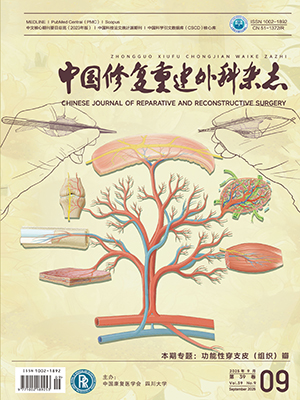Objective To evaluate the host immune reaction against adenovirus mediated human bone morphogenetic protein 2 (Adv-hBMP-2) gene therapy in repairof tibial defects. Methods Twelve goats were made 2.1 cm segmental defects in he tibial diaphysis and divided into 2 groups. AdvhBMP2 transfected marrow mesenchymal stem cells(MSCs) and untransfected MSCs were implanted into the defect sites of transfected group(n=7) and untransfected group (n=5), respectively. The defect repair was observed by X-ray films after 4, 8, 16 and 24 weeks of transplantation and cellular and humoral immune reactions to adenovirus were assayed before implantation and after implantation. Results More bony callus was found in the bone defects of transfected group. The healing rates were 6/7 in transfected group and 2/5 in untransfected group, respectively at 24 weeks after implantation. The mixed culture of lymphocytes and MSCs showed that the lymphocytes stimulation indexes (SI) increased 14 days after implantation, and there was significant difference between the transfected group (4.213±1.278) and the untransfected group(-0.310±0.147,P lt;0.05); SI decreased after 28 days, but there was no significant difference between the transfected group (2.544±0.957) and the untransfected group (3.104±0.644,P gt;0.05). After 14, 28, 49, and 120 days of treatment, the titer values of neutralizing antibody against Adv-hBMP-2 (log0.1) were 2.359±0226, 2.297±0.200, 2.214±0.215 and 2.297±0.210 in transfected group, and -0.175±0.335, -0.419±0.171, 0±0.171 and 0.874±0.524 in untransfected group, being significant differences betweentwo groups(P lt;0.05). Conclusion Adenovirus mediated BMP-2gene therapy can cause cellular and humoral immune reactions against adenovirus, which can eliminate the influence of adenoviral genes and proteins within a certain period.
Citation: XU Xiaoliang,DAI Kerong,TANG Tingting,et al.. AN IMMUNOLOGICAL STUDY ON ADENOVIRUS MEDIATED HUMAN BONE MORPHOGENETIC PROTEIN 2 GENE THERAPY. Chinese Journal of Reparative and Reconstructive Surgery, 2005, 19(8): 635-638. doi: Copy
Copyright © the editorial department of Chinese Journal of Reparative and Reconstructive Surgery of West China Medical Publisher. All rights reserved




